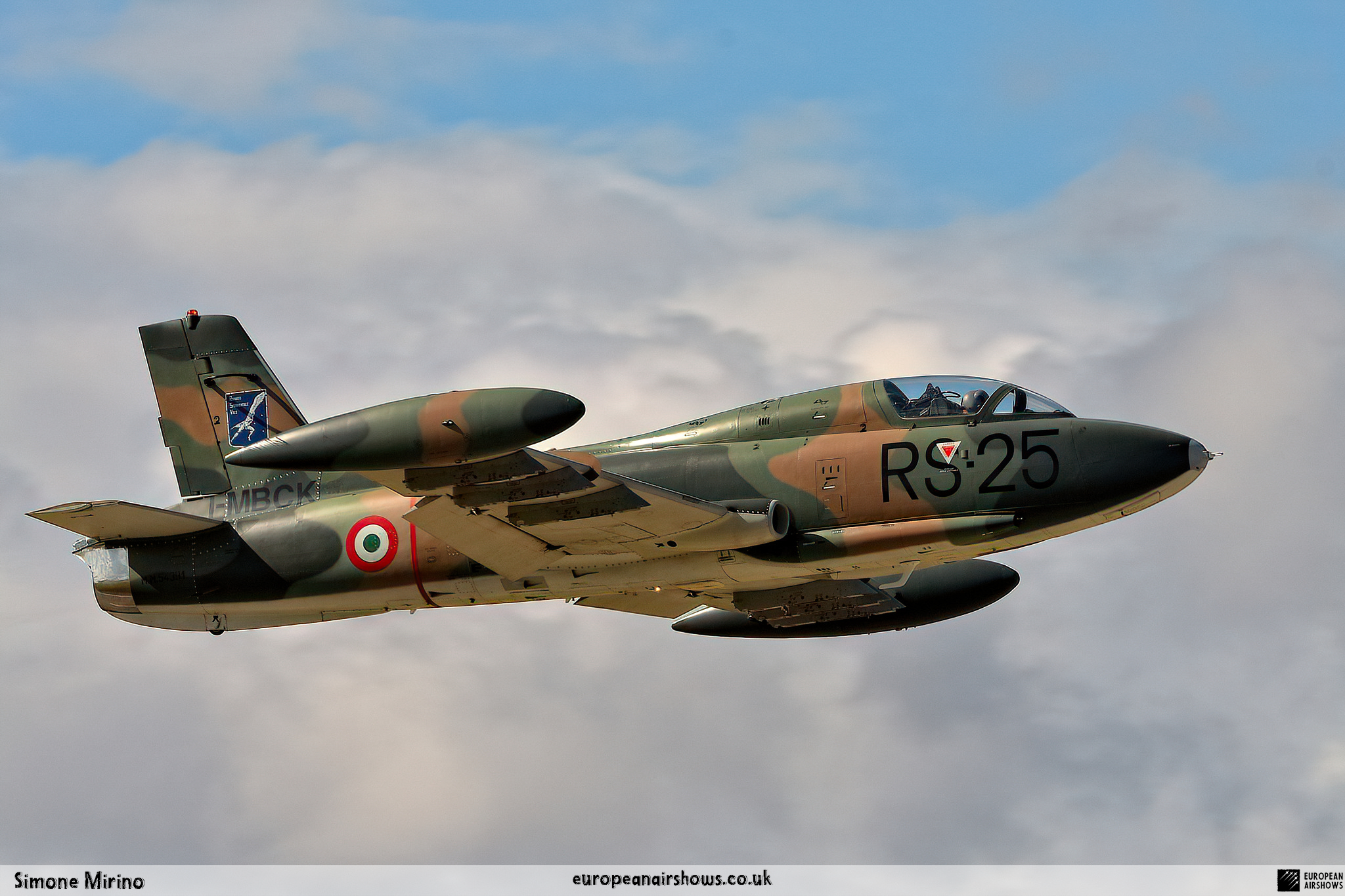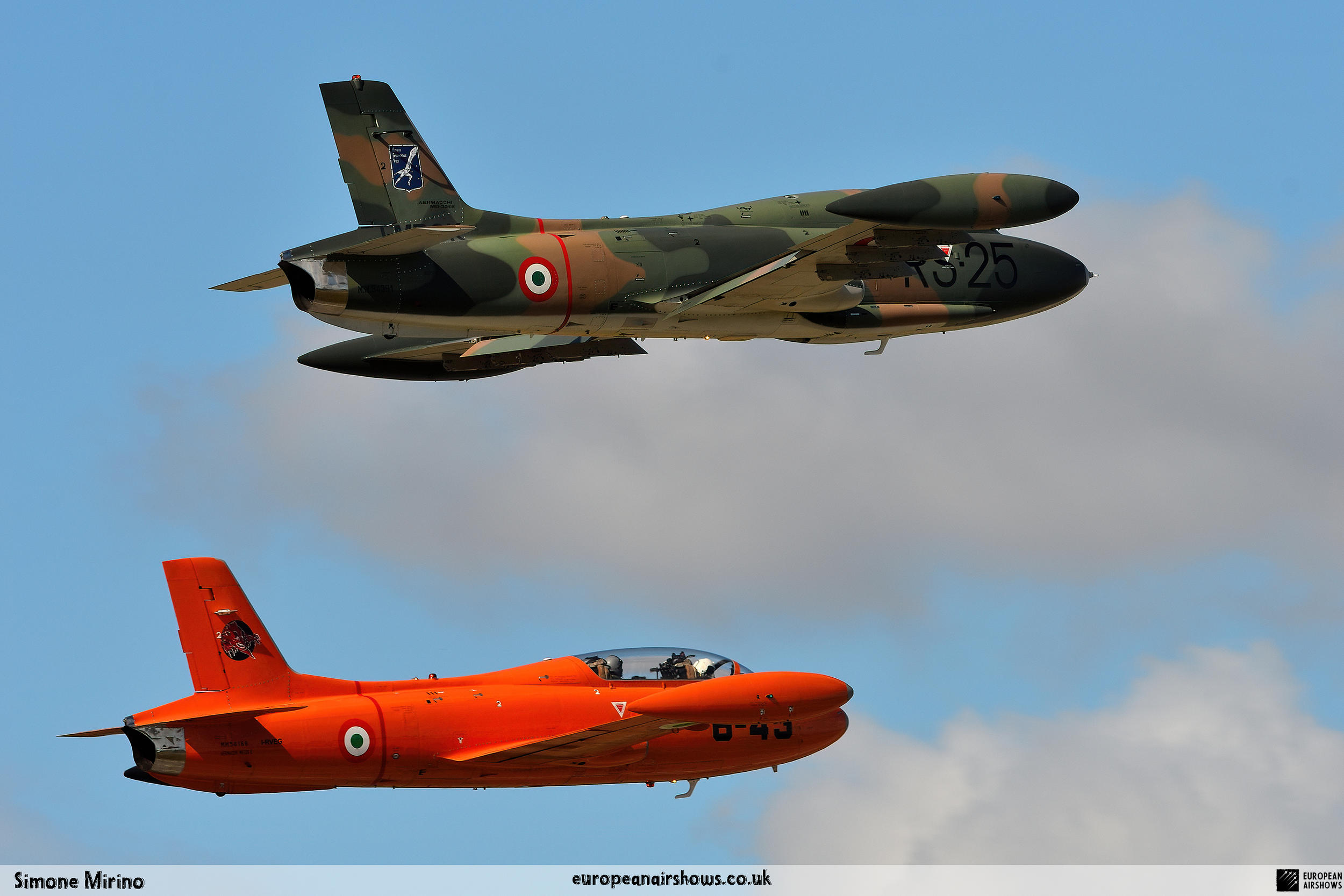MB-326 I-MBCK
Year built
1962
Aircraft
MB-326K
Base
Reggio Emilia Airport
Aermacchi began building this mb-326k (c/n 6754) for the Zairean military. The type was already in service in that African nation, now known as the Democratic Republic of the Congo, and this aircraft was part of a supplemental contract for eleven more examples. However, Zaire underwent financial difficulties which ended up causing contract cancellation part way through the construction process. When this contract collapsed, Aermacchi had nearly completed 6754’s manufacture however, without another customer footing the bill, it was hard to justify her final assembly. As a result, she languished in covered storage for several decades before Volafenice acquired the essentially new airframe.
Now registered as I-MBCK, the aircraft is painted to represent MM54391, an Italian Air Force example which served with 311° Gruppo/Reparto Sperimentale Volo (RSV), the flight test unit based at Pratica di Mare Air Base near Rome. Temporarily on the civilian registry as I-KMAK, the former MM54391 took part in a marketing campaign at several air shows and exhibitions (Le Bourget: 1971, 1972, 1975, 1979; Farnborough: 1972, 1974, 1976; Hampshire, 1978). But perhaps most importantly, MM54391 toured Brazil in 1974 where, in the hands of Aermacchi test pilot Franco Bonazzi, she performed numerous demonstrations at various Brazilian Air Force bases across the country.
| Back to Top |
Aermacchi MB-326K
MB-326K is a Single-seat ground-attack version of the MB-326. The Aermacchi or Macchi MB-326 is a light military jet trainer designed in Italy. Originally conceived as a two-seat trainer, there have also been single and two-seat light attack versions produced. It is one of the most commercially successful aircraft of its type, being bought by more than 10 countries and produced under licence in Australia, Brazil and South Africa. It set many category records, including an altitude record of 56,807 ft (17,315 m) on 18 March 1966. More than 800 MB-326s were constructed between 1961–1975.
The MB-326 had been developed and ordered during a period in which "all-through" jet training was considered by many air forces to be the most cost-effective model for training military pilots. It was intended to provide a single type of aircraft that could be used to perform both elementary and advanced training right through to a near combat-ready standard. In practice, it was soon discovered that the simplicity and economy of scale of operating just one type for all training purposes were outweighed by the purchase and operating costs of a large all-jet training fleet. Many operators soon switched to operating the MB-326 in conjunction with a cheaper piston-engined type for basic training purposes. Over time, the MB-326 found its primary role as a lead-in trainer to prepare pilots for transition to very high-performance fighter aircraft.
The Aermacchi MB-326 was a low-wing monoplane with an all-metal structure composed of light alloys. It was one of the first jet trainers to be developed with the aim of catering to both ab initio and advanced instruction. As originally developed, the MB-326 functioned as a refined but simple aircraft capable of covering the considerably wide range of performance characteristics required to cover both ab initio training and advanced instruction alike; other major characteristics of the type included the capacity to deliver a high rate of utilization in conjunction with minimised servicing and maintenance requirements. According to Flight International, the type was suitable for the teaching of the majority of advanced flying techniques. In addition to being relatively easy to fly, a high degree of safety was also intentionally built into it, including the adoption of new Martin-Baker-built ejection seats.
The MB-326 was powered by a single Rolls-Royce Viper non-afterburning turbojet engine, initial production aircraft were powered by the Viper 11 model, capable of generating up to 2,500 lb of thrust. The engine possessed multiple favourable attributes, including its general simplicity and robustness, relatively low revolutions per minute (RPM) and turbine entry temperature (TET), rapid acceleration, ease of installation, and its somewhat forgiving nature to mishandling in the air by students. Air was provided to the engine via a pair of low-profile intakes set into the wing roots. The Viper was produced under licence by Italian aviation company Piaggio following an agreement established with its original manufacturer, the British engine firm Bristol Siddeley, in 1959.
From a structural perspective, the MB-326 was relatively straightforward. Both the fuselage and the wing were constructed in three sections; of these, the centre section of the wing was integral to the fuselage. The fuselage was divided into a forward, central, and rear section; the forward section contained the nose wheel and radio systems; the centre part, accommodated the cockpit, fuel tanks and the engine; and the rear section which comprised both the tail unit and jet pipe. The fuel system had one large tank in the middle-fuselage and two in the wingtips; a single-point pressure-fuelling system is located on the starboard side of the aircraft to provide a total refuelling time of around five minutes. The rear of each wing had flaps, and ailerons with a trim surface; each wing had 22 ribs and two spars. Wing fences were added mid-wing to increase the lift characteristics. Accordingly, the MB-326 was readily capable of performing relatively slow speed take-off and landing while retaining an excellent rate of climb.
The MB-326 was outfitted with a tandem cockpit configuration, this arrangement had been chosen to result in a slimmer and more aerodynamically efficient fuselage in comparison to the more usual side-by-side arrangement. It was covered by a bubble canopy for excellent external visibility; it featured a windscreen anti-icing system powered by the engine compressor using bleed air. The cockpit was also pressurised, enabling the MB-326 to conduct high altitude flight. The ability to fly at higher altitudes was favourable for multiple purposes, including during the execution of aerobatic and navigational training, as well as improving fuel efficiency for long-distance flights. The onboard systems were typically pre-manufactured units that were easy both to access and to remove; several elements were also intentionally interchangeable. The exterior of the aircraft was covered by a total of 80 inspection panels and doors; in-situ engine inspection could be performed via a pair of large access panels set above and below the engine bay while another pair of doors allow access to the intake duct's interior for the inspection of the first-stage compressor rotor blades.
| Back to Top |




| Back to Top |







